Dui-level formations were scaled up from Wu-level formations. It consisted of four Wu (伍) and four porters, led by a Dui Zhang (隊長). From Dui-level onward, these formations became gradually more complex.
Fang Dui (方隊, square platoon)
Fang Dui was the square formation for Dui-level tactical unit. Unlike its smaller counterpart, Fang Dui was a defensive formation similar to a hollow square. Twenty-five troops were deployed inside a five chi by five chi square (it was actually more compact than its Wu-level counterpart), with all their weapons pointing outward. Platoon leader was positioned inside the square, surrounded by four porters. If the square was formed without porters, then the formation became slightly more flexible, occupying a six chi by six chi square. Every Wu inside the square was deployed in Er Zi Ping Wu (二字平伍) formation.
The formation could easily switch into a more offensive variant by ordering all troops to face a single direction.
Yuan Dui (圓隊, round platoon)
Yuan Dui was also a defensive formation similar to Fang Dui. Four Wu formed into a large circle using a modified Er Zi Ping Wu formation, with all their weapons pointing outward. Platoon leader and four porters were positioned inside the circle. Unlike Fang Dui, the porters were tasked with filling the gaps in the formation and had to be ready for combat. This formation could also be formed without the porters.
Qu Dui (曲隊, crooked platoon)
Qu Dui was an offensive formation for Dui-level tactical unit. Four Wu formed into two wings, followed by platoon leader and four porters. This formation resemble an inverted wedge formation.
Zhi Dui (直隊, straight platoon)
Zhi Dui was a versatile formation that came with two different variations. The first one was formed by four Zhi Wu (直伍) standing side by side, while the second one was formed by four Fang Wu (方伍), arranged in a two by two fashion. Four porters were positioned behind the formation. Platoon leader would lead the formation at the front during a march, stood between first rank and second rank during combat, and stood behind the formation to supervise or manage the formation.
As a side note, two Zhi Wu was also known as one Yuan Yang Wu (鴛鴦伍, lit. 'Mandarin Duck Team'), as it was basically a slightly modified Mandarin Duck Formation.
Rui Dui (銳隊, sharp platoon)
Rui Dui was an offensive rhombic formation for Dui-level tactical unit. As this was a very aggressive formation used to smash through enemy's line, the platoon leader had to lead at the front. Rui Dui could be modified into a
wedge-like formation if formed without porters, as it no longer had to defend them.
Fang Wu Yi Zi Dui (方伍一字隊, lit. 'Square team 'one' ideograph platoon')
Er Zi Dui was the upscaled version of Er Zi Ping Wu (二字平伍). It could be formed from either Yi Zi Ping Wu or Fang Wu, and could employ either rotation methods in both configurations.
Other blog posts in my De Sheng Bing series:
Xu Guang Qi's De Sheng Bing — Part 1
Xu Guang Qi's De Sheng Bing — Part 2
Xu Guang Qi's De Sheng Bing — Part 3-1
Xu Guang Qi's De Sheng Bing — Part 3-2
Xu Guang Qi's De Sheng Bing — Part 4
Xu Guang Qi's De Sheng Bing — Part 5
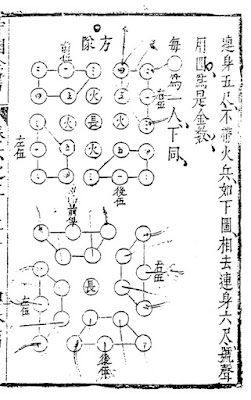 |
| Layouts of Fang Dui, from 'Xuan Lian Tiao Ge (《選練条格》)'. |
The formation could easily switch into a more offensive variant by ordering all troops to face a single direction.
Yuan Dui (圓隊, round platoon)
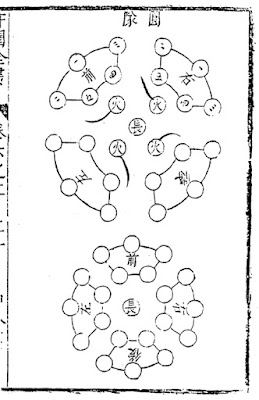 |
| Layouts of Yuan Dui, from 'Xuan Lian Tiao Ge (《選練条格》)'. |
Qu Dui (曲隊, crooked platoon)
 |
| Basic layout of a Qu Dui, from 'Xuan Lian Tiao Ge (《選練条格》)'. |
Zhi Dui (直隊, straight platoon)
 |
| Two variations of Zhi Dui, from 'Xuan Lian Tiao Ge (《選練条格》)'. |
As a side note, two Zhi Wu was also known as one Yuan Yang Wu (鴛鴦伍, lit. 'Mandarin Duck Team'), as it was basically a slightly modified Mandarin Duck Formation.
Rui Dui (銳隊, sharp platoon)
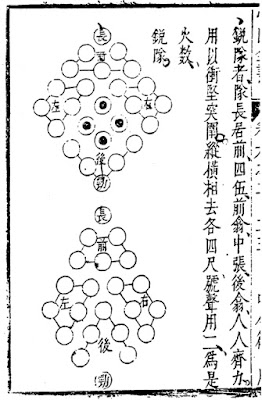 |
| Two variations of Rui Dui, from 'Xuan Lian Tiao Ge (《選練条格》)'. |
Fang Wu Yi Zi Dui (方伍一字隊, lit. 'Square team 'one' ideograph platoon')
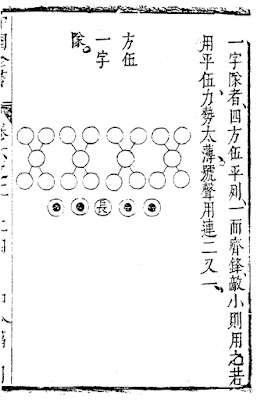 |
| Layout of a Fang Wu Yi Zi Dui, from 'Xuan Lian Tiao Ge (《選練条格》)'. |
Fang Wu Yi Zi Dui was basically an upscaled Yi Zi Ping Wu (一字平伍), formed by four Fang Wu standing side by side, followed by platoon leader and porters.
Unit Rotation
Like the ancient Roman army, Ming army had a system of rotating unit in and out of action, allowing exhausted troops to recuperate while replenish the front line with fresh troops. Xu Guang Qi (徐光啟) wrote down two different methods of unit rotation for his new army: Chou (抽, draw) and Die (叠, stack). Both methods were adopted directly from the battle formations of Yu Da You (俞大猷).
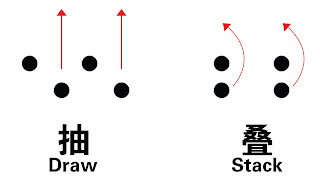 |
| A simple diagram showing the difference between Chou method and Die method. |
Er Zi Dui (二字隊, lit. ''Two' ideograph platoon')
 |
| Top: Er Zi Dui Ping Wu rotating using Chou method. Bottom: Er Zi Dui Ping Wu rotating using Die method. From 'Xuan Lian Tiao Ge (《選練条格》)'. |
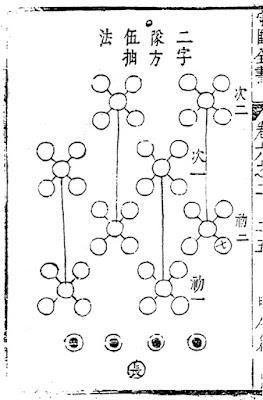 |
| Er Zi Dui Fang Wu rotating using Chou method, from 'Xuan Lian Tiao Ge (《選練条格》)'. |
 |
| Er Zi Dui Fang Wu rotating using Die method, from 'Xuan Lian Tiao Ge (《選練条格》)'. |
Other blog posts in my De Sheng Bing series:
Xu Guang Qi's De Sheng Bing — Part 1
Xu Guang Qi's De Sheng Bing — Part 2
Xu Guang Qi's De Sheng Bing — Part 3-1
Xu Guang Qi's De Sheng Bing — Part 3-2
Xu Guang Qi's De Sheng Bing — Part 4
Xu Guang Qi's De Sheng Bing — Part 5
No comments:
Post a Comment